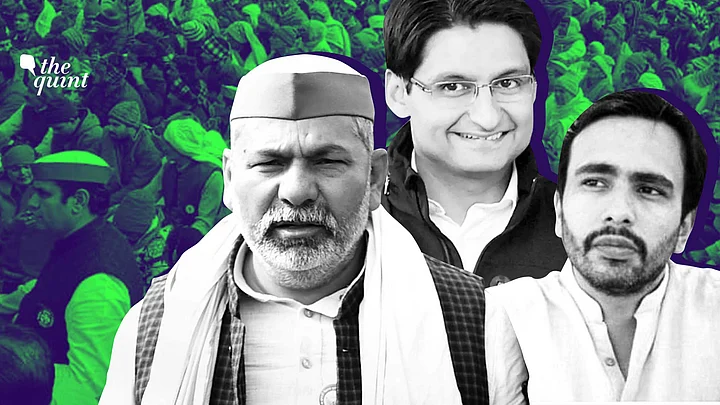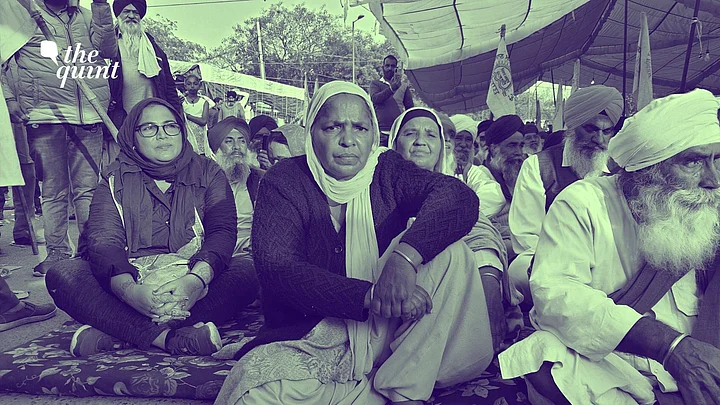(This story was first published on 5 February, 2021. It has been republished from The Quint's archives to mark International Women's Day.)
CAMERA: SHIV KUMAR MAURYA
VIDEO EDITOR: MOHD IRSHAD ALAM
As lakhs of farmers continue their protest against the new farm legislations introduced by the Modi government, a remarkable number of women are not only braving the rough weather by participating in these demonstrations but are also leading from the front.
The agitation which has now entered its third month is being deemed as one of the world’s biggest protests where farmers from several states in the country marched to India’s national capital in late November and early December of 2020.
The Quint travelled to the Tikri Border and spoke to women leaders. We asked them about their roles in the movement and the motivation behind participation in the agitation in such huge numbers.
JASBIR KAUR NATT – State Committee Member, Punjab Kisan Union

Sixty-five-year-old Jasbir Kaur Natt has been a farmers’ and labourers’ rights activist for more than 30 years. She is a state committee member of the Punjab Kisaan Union and is identified as a communist. We met her near the main stage at the Tikri Border, where, as the head of the steering committee, she is responsible for handling the speakers and the crowd. “In addition to being a farmer leader, I am also a communist. I have been associated with several organisations since 1986,” Natt stated.
We spent a day following her through the protest and what we saw was relentless and tireless determination, ensuring everything runs smoothly.
From 7 am to 9 pm: Here’s How Jasbir Kaur Day at Tikri Looks Like
Kaur, along with her husband, daughter and son, stays in a makeshift tent under the Metro bridge at Tikri. She wakes up at 7 am and leaves for the main stage by 9:30 am. What begins next is a series of meetings with leaders of several farmer unions on the road ahead for the movement. At around 11 am, she takes her job of managing the stage, ensuring that speakers from all the unions get a fair chance to speak.
“The steering committee which decides the order of speakers. I make notes in my register for these duties. My job is to ensure that all unions get enough and equal time to speak. Then, being the incharge of the fund committee, I have to keep a daily account of funds received and utilised. I have kept an account of funds from day one till today.”Jasbir Kaur Natt, State Committee Member (Punjab Kisaan Union)

After handling proceedings near the main stage till around 4 pm, Natt returns to her tent for lunch and then helps with dinner. “When I am done with my duties around the stage, I then supervise the food preparations here. Sometimes, I also do the dishes,” she said.
‘Didn’t Become an Activist Overnight’
Speaking about the role of women in the movement, Natt stressed on the fact that women, especially from Punjab and Haryana, have been at the forefront of the fight against the controversial farm laws. She also told us that those who think that women are being forcibly brought to the protest site must know that women play a very crucial role in agriculture and are very well equipped to understand the laws.
“People believe that a woman is an object which has been brought to the protest forcibly. As if they don’t have the ability to think on their own. I have been fighting for farmers since 1986. As a result, I have also been jailed and slapped with court cases multiple times. We know what we are protesting against.”Jasbir Kaur Natt, State Committee Member (Punjab Kisaan Union)
Harinder Kaur Bindu – Leader, Bharatiya Kisan Union (BKU) Ekta Ugrahan

Harinder Kaur Bindu, 43, is a leader of the Bharatiya Kisan Union (BKU) Ekta Ugrahan faction and is fondly called Bindu by her fellow protesters. Her everyday jobs at the protest site in Tikri involve speaking to the press, relaying messages sent by union leaders to other protesters and meeting people who come to donate funds for the cause. “I wake up at 5 am and am able to sleep only after 11 pm,” Kaur told us.
‘Lost My Father to Khalistan Insurgency in the ’90s’
Speaking about her childhood, Bindu recollects how her father lost his life fighting against the Khalistanis on 9 April 1991.
“My father was a member of the Nau Jawan Bharat Sabha. In the ’90s, we saw the rise of Khalistan insurgency in Punjab. At that time, he worked to educate people against it. On 9 April 1991, he lost his life fighting against the Khalistanis. He sacrificed his life for the people.”Harinder Kaur Bindu, Member, Bharatiya Kisan Union (BKU) Ekta Ugrahan
She further adds that the spark of revolutionary ideas has always been part of her family and her father’s sacrifice pushed her into activism as a full-time career. Since then, she has worked for the rights of farmers, Dalits and women.

How Gender Roles Are Being Reversed at the Farmers’ Protest
As we went around the Tikri protest site with Harinder Bindu, she told us that the agitation is being purposely managed in a way so that women aren’t restricted to jobs like cooking or cleaning the area. “A lot of thinking has gone into this design. Women usually handle the kitchen at home. If they do the same thing here, how will the movement enlighten them?” she explained.
Further, stressing on the role of women in the movement, Bindu told us that she has a message for the Narendra Modi government.
“We want to send a message for the BJP government which is following the teachings of the ‘Manusmriti’, which equates women with animals. We want them to warn them, to stop their efforts in suppressing women and denying us our right to unionise. We want to tell them that we won’t sit at home.”Harinder Kaur Bindu, Member, Bharatiya Kisan Union (BKU) Ekta Ugrahan
Navkiran Natt – Student Youth Activist, AISA

A much younger Navkiran Natt is a student youth activist with the All India Students’ Association (AISA) and Revolutionary Youth Association (RYA). She has been a part of the farmers’ protest since November 2020. Natt believes that hailing from Punjab and, to top it all, belonging to an agricultural family has made it impossible for her to stay away from the protests.
At Tikri, Natt and her friends started the Trolley Times, a protest’s newspaper which is now being published in three languages and circulated at protest sites across Delhi.
“We felt that there were serious connectivity issues at the protest sites. People could not keep a track of what was going on, on the main stage. People at one border could not connect with those at the other because of connectivity issues. We thought that a newspaper can help resolve these problems, and that was when we started the Trolley Times.”Navkiran Natt, Student Youth Activist
‘Some Aspects of the Protest Go Beyond Political Gains’
Speaking about the concept of domestic labour at the protest site, Natt shared with us an interesting anecdote.
“Once, I was writing slogans on a wall at Tikri and I was hungry. I looked around and saw a few young and middle-aged men cooking. I went to them and told them that I was hungry. They offered me food and we started talking. A 20-21-year-old young man came up to me and said that he could not even knead the dough when he came to the protests, but now can make well-rounded rotis.”
Talking about the patriarchal nature of agrarian societies, she further emphasised that the ongoing agitation is unique in the sense that there are no pre-defined gender roles there.

‘It Hurts When the Media or the State Tries to Snatch Our Agency’
Sitting beside her father at pillar number 783 at the Tikri Border, Navkiran told us that she has grown watching women leaders, including her mother Jasbir Kaur Natt, struggle for the rights of the disadvantaged sections of the society. “My mother has been an activist for 35 years. She has been actively speaking for these issues since early ’90s,” she said.
“When I was born, my father was in jail. He has been jailed during protests almost six times, while my mother has been jailed thrice for participating in farmers’ agitations over the years. I think the CJI’s statement is a cruel joke, because I have seen these women fight the same issues for over years. Then how do I believe that they’ve been kept at the protests?”Navkiran Natt, Student Youth Activist
Women make for a very significant and crucial part of the farmers’ movement. They are not only actively participating in the protests but are also holding the fort back home and looking after the farms in the absence of other family members. They have strong opinions on the farm laws and are firm on their decision of not returning home, till the legislations are repealed by the government.
(At The Quint, we question everything. Play an active role in shaping our journalism by becoming a member today.)





